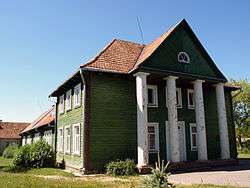Bezdonys
| Bezdonys | |
|---|---|
| Town | |
|
Bezdonys high school (Lithuanian) | |
 Bezdonys Location of Bezdonys | |
| Coordinates: 54°48′16″N 25°31′09″E / 54.80444°N 25.51917°ECoordinates: 54°48′16″N 25°31′09″E / 54.80444°N 25.51917°E | |
| Country |
|
| County | Vilnius County |
| Municipality | Vilnius district municipality |
| Eldership | Bezdonys eldership |
| Capital of | Bezdonys eldership |
| Population (2001) | |
| • Total | 857 |
| Time zone | EET (UTC+2) |
| • Summer (DST) | EEST (UTC+3) |
Bezdonys is a town in Lithuania, located to the north of Vilnius, within the Vilnius district municipality. It is best known for the 1908 Bezdany raid, one of the most daring and successful train robberies in history.[1][2] According to the 2001 census, the town had 857 inhabitants.[3]
History
The site of the modern village has been inhabited at least since early Middle Ages. Local dense forests were a hunting resort of the Grand Dukes. Jan Długosz mentions, that the local hunting manor was visited by the Grand Duke of Lithuania Jogaila who was later elected as a king Władysław I of Poland. In 1516 a hunting manor and surrounding land was granted by Grand Duke of Lithuania Sigismund I the Old to Ulryk Hozjusz, better known as father of Stanisław Hozjusz.[4] The area donated to the Hozjusz family consisted of roughly 7000 hectares of forests, with a single mill and three villages (two of them – Żwiniany and Łuczniki – do not exist any more).[5]
On March 1, 1605 Ulryk Hozjusz's great-grandson sold the village and the adjoining land for 5000 złoty to canon of Vilna Wilczopolski, who in turn donated it to the Jesuits in 1609.[4] The village remained administered by the Jesuits until the suppression of the Society of Jesus in 1774. The area was taken over by the royal treasury, but already on July 12 of that year king Stanislaus Augustus of Poland donated it to Mikołaj Łopaciński in exchange for a yearly donation for the Commission of National Education.[nb 1] At that time the village had roughly 300 inhabitants, including roughly 20 noble families.[5]
After the Partitions of Poland the village remained in the hands of the Łopaciński family. The yearly fee however was instead paid to Saint Petersburg. Following the January Uprising the peasants living in Bezdany were granted with roughly 400 hectares (or desiatinas) of land.[4] On March 15, 1862 the Warsaw – Saint Petersburg Railway was opened and one of its stations was located in Bezdany (or Безданы in Russian). It was there that the Bezdany raid of September 26, 1908 took place. A group of Polish revolutionaries led by Józef Piłsudski stole roughly 200,000 Russian rubles[nb 2] from a passenger train.
After Poland regained independence, the village started to grow. Marian Zyndram-Kościałkowski, the owner of the nearby village of Orwidowo (modern Arvydai) and future Prime Minister of Poland financed a new public school in Bezdany.[5] Also, in 1937 a new wooden church was opened in the presence of the President of Poland Ignacy Mościcki.[5] Until then, the nearest church was located in Niemenczyn (modern Nemenčinė), 8 kilometres away. By the end of the 1930s the village grew to almost 500 inhabitants and 70 houses.[5] Following World War II the village was annexed by the USSR and attached to the Lithuanian SSR. Roughly half of pre-war inhabitants were evicted and expelled to within post-war Poland.[6] In 1946 a Russian language class was added to the Polish language school, in 1957 also Lithuanian language class was opened. In 1968 a new school building was opened and in 1992 a new Lithuanian language only school was built.
Notes
- ↑ Specifically Łopaciński and his heirs were to pay 4,5% of the value of the village, estimated at 72222 złoty 6 2⁄3 grosz
- ↑ Roughly 100,000 contemporary US Dollars, or almost 10,000,000 in 2007 dollars (using the unskilled wage indicator of relative worth). See: measuringworth.com
References
- ↑ (Polish) Bohdan Urbankowski, Józef Piłsudski: marzyciel i strateg (Józef Piłsudski: Dreamer and Strategist), Wydawnictwo ALFA, Warsaw, 1997, ISBN 83-7001-914-5, p. 133-141
- ↑ (Polish) Exceprts from W. Pobóg-Malinowski, "Akcja bojowa pod Bezdanami, 26 IX 1908". Quoted from Nasza Gazeta 10 (446). Last accessed on 30 May 2006.
- ↑ Vilniaus apskrities kaimo gyvenamosios vietovės ir jų gyventojai (PDF) (in Lithuanian). Vilnius: Department of Statistics to the Government of the Republic of Lithuania. 2003. ISBN 9955-588-04-7.
- 1 2 3 Filip Sulimierski; Bronisław Chlebowski; Władysław Walewski, eds. (1885). Słownik geograficzny Królestwa Polskiego i innych krajów słowiańskich (in Polish). I. Warsaw: Wł. Walewski. p. 960. Retrieved 2008-08-28.
- 1 2 3 4 5 Mirosław Gajewski. "Z historii Bezdan". Nasza Gazeta (in Polish). 10 (446). Retrieved 2008-08-28.
- ↑ Czesława Paczkowska (February–March 2008). "Gminy z dorobkiem w tle – Bezdany". Tygodnik Wileńszczyzny (in Polish). 9 (390). Retrieved 2008-08-28.
External links
| Wikimedia Commons has media related to Bezdonys. |
- (Lithuanian) Pictures
- 1925 map of Bezdany and its surroundings

